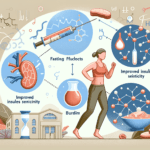Are you looking for effective ways to improve your insulin sensitivity through intermittent fasting? Look no further! In this article, we will explore the best techniques for intermittent fasting that can help enhance your body’s response to insulin. By implementing these strategies, you can potentially reduce the risk of developing conditions like diabetes and improve overall metabolic health. So, let’s dive in and discover the secrets to achieving optimal insulin sensitivity through intermittent fasting.
Time-Restricted Eating
Time-restricted eating is a popular method of intermittent fasting that focuses on adjusting meal timing to optimize insulin sensitivity. The idea behind this technique is to restrict your eating window to a specific period of time each day, typically between 8 and 12 hours, while fasting for the remaining hours. By doing so, you give your body a break from digesting food, allowing it to focus on other important processes such as repairing cells and regulating hormones.
Adjusting Meal Timing
To implement time-restricted eating, you need to determine the optimal eating window that works best for you. This can vary depending on your lifestyle and personal preferences. For example, if you are a morning person, you may choose to have your eating window from 8 am to 4 pm. On the other hand, if you prefer evening meals, you might opt for a eating window from 12 pm to 8 pm. Experiment with different time frames to find what fits your schedule and helps you maintain consistency.
Fasting Duration
While time-restricted eating focuses on the eating window, it is important to note that the fasting duration also plays a crucial role in improving insulin sensitivity. Most experts recommend fasting for at least 12-16 hours to experience the benefits. This means that if your eating window is from 10 am to 6 pm, you would fast from 6 pm to 10 am the following day.
Optimal Eating Window
The optimal eating window for improving insulin sensitivity may vary for each individual. Some studies suggest that a shorter eating window, such as 6-8 hours, may be more effective in regulating insulin levels. However, it is important to choose a window that allows you to meet your nutritional needs and fits your lifestyle. Experiment and listen to your body to find the eating window that works best for you.
Alternate Day Fasting
Alternate day fasting involves alternating between fasting days and regular eating days. This method is known to be more challenging, but it can offer significant benefits for improving insulin sensitivity.
24-Hour Fasting
The most common form of alternate day fasting involves fasting for a full 24 hours, followed by a day of normal eating. This fasting method can be challenging, especially for beginners, but it has shown to be effective in improving insulin sensitivity and promoting weight loss.
Modified Alternate Day Fasting
For those who find full-day fasting too difficult, modified alternate day fasting offers a more manageable approach. This method involves limiting your calorie intake to around 500-600 calories on fasting days, while eating normally on non-fasting days. While this approach may not provide the same level of insulin sensitivity improvements as full-day fasting, it can still be effective for weight management and overall health.
Benefits and Risks
Alternate day fasting has been shown to improve insulin sensitivity, promote weight loss, and reduce the risk of chronic diseases. However, it is important to note that this fasting method may not be suitable for everyone. Individuals with certain medical conditions, such as diabetes or eating disorders, should consult with a healthcare professional before attempting alternate day fasting. It is also important to listen to your body and ensure you are consuming adequate nutrients on non-fasting days to support overall health.

5:2 Fasting
5:2 fasting is another popular intermittent fasting method that involves eating normally for five days of the week and restricting calorie intake on two non-consecutive days. This approach provides flexibility while still offering the benefits of intermittent fasting.
Description of 5:2 Fasting
In the 5:2 fasting method, you eat normally for five days of the week, while restricting your calorie intake to around 500-600 calories on two non-consecutive days. These fasting days can be chosen based on your schedule and personal preferences, as long as they are not consecutive. For example, you may choose to fast on Mondays and Thursdays while eating normally on the remaining days.
How it Improves Insulin Sensitivity
5:2 fasting has been shown to improve insulin sensitivity by promoting weight loss, reducing inflammation, and enhancing cellular repair processes. The restricted calorie intake on fasting days can also help regulate blood sugar levels and improve overall metabolic health.
Sample Meal Plan
On fasting days of the 5:2 fasting method, it is important to choose nutrient-dense foods that are low in calories. Here is a sample meal plan for a fasting day:
- Breakfast: A cup of green tea or black coffee (with no added sugar or milk) to help suppress appetite.
- Lunch: A mixed green salad with a variety of vegetables, topped with grilled chicken breast or tofu. Dress with a light vinaigrette.
- Snack: A handful of raw almonds or a small piece of fruit for a nutritious and satisfying snack.
- Dinner: Steamed or roasted vegetables with a small portion of lean protein, such as fish or chicken. Season with herbs and spices for flavor.
Remember to consult with a healthcare professional or registered dietitian before starting any new fasting or dietary regimen to ensure it aligns with your specific health needs and goals.
OMAD (One Meal a Day)
OMAD, also known as One Meal a Day, is a fasting method where you eat only one large meal within a short eating window each day. This approach can provide numerous benefits for improving insulin sensitivity.
Overview of OMAD
With OMAD, you fast for approximately 23 hours a day and consume all your daily calories within a one-hour eating window. This method allows your body to fully enter a fasted state, promoting fat burning and improving insulin sensitivity.
Benefits for Insulin Sensitivity
By practicing OMAD, you give your body an extended period of time without food, allowing insulin levels to decrease and increasing its sensitivity to insulin when you do eat. This can lead to better blood sugar control, reduced insulin resistance, and improved overall metabolic health.
Tips for Practicing OMAD
While OMAD can be an effective fasting method for improving insulin sensitivity, it is important to approach it with caution. Here are some tips to help you practice OMAD safely:
- Start gradually: If you are new to fasting, it is recommended to start with shorter fasting durations and gradually increase the fasting window until you can comfortably practice OMAD.
- Stay hydrated: Drink plenty of water throughout the day to stay hydrated and help curb hunger.
- Prioritize nutrient-dense foods: Since you are only consuming one meal a day, make sure it is packed with essential nutrients. Include a variety of vegetables, lean protein, healthy fats, and whole grains to nourish your body.
- Listen to your body: Pay attention to your hunger and fullness cues. If you are feeling extremely hungry or experiencing any negative side effects, it is important to adjust your approach or consult with a healthcare professional.
Remember that OMAD may not be suitable for everyone, especially those with certain medical conditions or a history of disordered eating. Consulting with a healthcare professional or registered dietitian is always recommended before starting any new fasting method.

Carb Cycling
Carb cycling is a fasting technique that alternates between high and low carbohydrate intake days. This approach can have a positive impact on insulin sensitivity and provide a more flexible approach to intermittent fasting.
Understanding Carb Cycling
Carb cycling involves cycling between days of higher carbohydrate consumption and days of lower carbohydrate intake. On high carbohydrate days, you consume a higher amount of carbohydrates to fuel your body, while on low carbohydrate days, you restrict your carbohydrate intake to promote fat burning and improve insulin sensitivity.
Impact on Insulin Sensitivity
By alternating between high and low carbohydrate days, carb cycling can help optimize insulin sensitivity. On low carbohydrate days, your body relies more on fat for fuel, reducing the demand for insulin production. This can lead to improved insulin sensitivity and better blood sugar control.
Sample Carb Cycling Plan
Here is an example of a carb cycling plan:
- High carbohydrate days: On these days, aim to consume around 1-2 grams of carbohydrates per kilogram of body weight. Include complex carbohydrates such as whole grains, fruits, and starchy vegetables in your meals.
- Low carbohydrate days: On these days, restrict your carbohydrate intake to less than 50 grams per day. Focus on protein-rich foods, healthy fats, non-starchy vegetables, and fiber-rich foods.
It’s important to note that carb cycling may not be suitable for everyone, especially those with certain medical conditions or individual dietary needs. Consulting with a healthcare professional or registered dietitian can help determine if carb cycling is appropriate for you.
Protein-Rich Fasting
Protein-rich fasting is a fasting method that focuses on consuming a higher proportion of protein during the eating window. This approach can provide numerous benefits for insulin sensitivity and overall health.
Importance of Protein
Protein is an essential macronutrient that is crucial for various bodily functions, including muscle repair, hormone production, and immune function. Consuming an adequate amount of protein can also promote satiety, help preserve lean muscle mass, and support weight management.
Benefits for Insulin Sensitivity
By prioritizing protein during your eating window, you can improve insulin sensitivity and regulate blood sugar levels. Protein has a minimal impact on blood sugar compared to carbohydrates, which can help prevent insulin spikes and reduce insulin resistance.
Protein-Rich Fasting Approaches
There are several approaches to protein-rich fasting, including:
- Increasing protein intake: Aim to include a source of lean protein, such as chicken, fish, tofu, or legumes, in every meal and snack during your eating window.
- Protein-focused meal replacements: Replace one or two meals with a protein-rich shake or bar to increase protein intake and optimize insulin sensitivity.
- Protein cycling: Alternate between days of higher and lower protein intake. On high protein days, aim to consume more protein-rich foods, while on low protein days, focus on other macronutrients such as healthy fats and vegetables.
As with any fasting method or dietary approach, it is important to consult with a healthcare professional or registered dietitian to determine if protein-rich fasting is appropriate for you and to ensure you are meeting your nutrient needs.
Exercise and Fasting
Exercising in a fasted state can be an effective way to improve insulin sensitivity and maximize the benefits of intermittent fasting. Combining exercise with fasting can have numerous positive effects on your overall health.
Exercising in a Fasted State
Exercising in a fasted state involves performing physical activity while in a state of fasting, typically during the morning before consuming any food. When you exercise in a fasted state, your body relies more on stored fat for fuel, which can aid in weight management and improve insulin sensitivity.
Benefits for Insulin Sensitivity
Exercising in a fasted state has been shown to increase insulin sensitivity and enhance glucose uptake by muscles. This can lead to better blood sugar control, reduced insulin resistance, and improved overall metabolic health.
Recommended Exercises
When exercising in a fasted state, engaging in a combination of cardiovascular exercises, strength training, and high-intensity interval training (HIIT) can provide the most benefits for insulin sensitivity. Here are some recommended exercises:
- Cardiovascular exercises: Activities such as running, cycling, swimming, or brisk walking can help improve cardiovascular health and burn calories.
- Strength training: Incorporate resistance training exercises using weights or resistance bands to build lean muscle mass, which can help improve insulin sensitivity.
- High-intensity interval training (HIIT): HIIT involves short bursts of intense exercise followed by periods of rest. This type of training can help boost metabolism and improve insulin sensitivity.
Remember to listen to your body and adjust the intensity and duration of your workouts to suit your fitness level. It is also important to consult with a healthcare professional or certified fitness trainer to ensure you are exercising safely and effectively.
High-Fiber Fasting
Including high-fiber foods in your fasting regimen can have a positive impact on insulin sensitivity and overall health. Fiber-rich foods can support digestion, regulate blood sugar levels, and promote satiety.
Fiber and Insulin Sensitivity
Dietary fiber, which is found in plant-based foods such as fruits, vegetables, legumes, and whole grains, can help regulate blood sugar levels and improve insulin sensitivity. Fiber slows down the digestion and absorption of carbohydrates, preventing rapid spikes in blood sugar and supporting stable insulin levels.
Foods to Include
To incorporate high-fiber foods into your fasting regimen, focus on the following:
- Fruits and vegetables: Aim to include a variety of colorful fruits and vegetables in your meals. These can be enjoyed raw, steamed, roasted, or in smoothies.
- Legumes: Include legumes such as beans, lentils, and chickpeas in your meals and snacks. These are not only high in fiber but also provide a good source of plant-based protein.
- Whole grains: Choose whole grain options such as brown rice, quinoa, whole wheat bread, and oats. These are higher in fiber and provide more nutrients compared to refined grains.
Meal Ideas
Here are some high-fiber meal ideas to incorporate into your fasting regimen:
- Breakfast: Overnight oats topped with mixed berries and a tablespoon of chia seeds.
- Lunch: A large salad with mixed greens, roasted vegetables, grilled chicken or tofu, and a sprinkle of nuts or seeds for added crunch and fiber.
- Dinner: Quinoa-stuffed bell peppers with lean ground turkey or a plant-based protein substitute, mixed with diced vegetables and herbs.
- Snack: A small handful of raw almonds or a piece of whole fruit.
Remember to maintain an adequate fluid intake when consuming high-fiber foods to support digestion and prevent constipation. If you have any specific dietary concerns or medical conditions, consult with a healthcare professional or registered dietitian to discuss the most appropriate high-fiber options for you.
Water Fasting
Water fasting is a more extreme form of fasting that involves consuming only water for a defined period of time. While it can provide certain benefits for insulin sensitivity, it is important to approach water fasting with caution and under proper medical supervision.
Overview of Water Fasting
Water fasting involves abstaining from all food and consuming only water for a specific duration, which can range from a few days to several weeks. During this time, your body enters a state of ketosis, where it begins to use stored fat for energy.
Effects on Insulin Sensitivity
Water fasting can potentially improve insulin sensitivity by allowing your body to reset and regulate its hormone levels. By consuming only water, you eliminate the intake of carbohydrates and calories, which can help reduce insulin resistance and promote fat burning.
Guidelines and Precautions
Water fasting should only be attempted under the guidance of a healthcare professional or experienced fasting specialist. It is important to take the following precautions:
- Duration: The duration of water fasting should be determined by a healthcare professional based on individual needs and medical history. Extended fasts should only be done under close medical supervision.
- Hydration: Drink an adequate amount of water throughout the fasting period to prevent dehydration.
- Rest and self-care: During water fasting, it is important to rest and engage in self-care activities to support your overall well-being.
- Breaking the fast: Gradually reintroduce solid foods after the fasting period to prevent any digestive discomfort or complications.
It is crucial to consult with a healthcare professional before attempting water fasting to ensure it is safe and appropriate for your specific health needs.
Intermittent Fasting with Medical Supervision
Intermittent fasting can be a beneficial approach for improving insulin sensitivity, but it may not be suitable for everyone. It is important to seek medical supervision, especially if you have certain medical conditions or if you are taking medications that can be affected by changes in your diet.
Consulting a Healthcare Professional
Before starting any fasting regimen, it is recommended to consult with a healthcare professional, such as a registered dietitian or physician, to determine the most appropriate approach for your specific health needs and goals. They can provide personalized guidance and monitor your progress to ensure safety and effectiveness.
Conditions that May Require Supervision
Certain medical conditions may require medical supervision when practicing intermittent fasting. These conditions include:
- Diabetes: Individuals with diabetes may need to adjust their medication or insulin regimen to prevent complications and maintain stable blood sugar levels.
- Eating disorders: Fasting can trigger disordered eating behaviors or exacerbate existing eating disorders. It is crucial to work closely with a healthcare professional or therapist who specializes in eating disorders to ensure a safe and healthy approach.
- Pregnancy or breastfeeding: Fasting during pregnancy or breastfeeding can have potential risks for both the mother and baby. It is important to consult with an obstetrician or healthcare professional before making any changes to your diet during this time.
- Underweight or nutrient deficiencies: If you are underweight or already have nutrient deficiencies, fasting may further compromise your health. Medical supervision can help ensure that your nutritional needs are being met while fasting.
Monitoring Insulin Sensitivity Regular monitoring of insulin sensitivity is essential when practicing intermittent fasting. This can be done through blood tests to measure fasting glucose levels, insulin levels, and other relevant markers of metabolic health. By monitoring these markers, healthcare professionals can track progress, make necessary adjustments, and ensure that intermittent fasting is positively impacting your insulin sensitivity and overall well-being.
In conclusion, there are various intermittent fasting techniques that can be effective in improving insulin sensitivity. Time-restricted eating, alternate day fasting, 5:2 fasting, OMAD, carb cycling, protein-rich fasting, exercising in a fasted state, high-fiber fasting, water fasting, and intermittent fasting with medical supervision all offer unique approaches and benefits. However, it is crucial to consult with a healthcare professional or registered dietitian before starting any new fasting regimen to ensure it aligns with your specific needs and goals. Remember to prioritize your overall health and well-being throughout your intermittent fasting journey.








